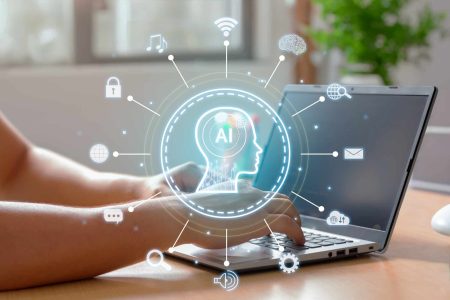Artificial Intelligence (AI) is a broad field, imbibed deeply with agents that vary in complexity and function. An agent in AI refers to any entity that perceives its environment through sensors and acts upon that environment using actuators. Understanding these entities involves delving into the different categories that outline their capabilities and operational modes. From simple reflex agents that respond directly to changes in the environment, to more complex model-based reflex agents that maintain internal status to handle unobservable situations, the variations are extensive. AI extends further into goal-based agents which act to achieve specific outcomes, and utility-based agents that measure their success based on a performance criterion. AI’s sophistication peaks with learning agents, capable of adapting their responses based on feedback from their environment. These agents play pivotal roles in contemporary technology, enhancing automation and decision-making processes across multiple sectors. As we continue to innovate, the development of AI agents stands as a testament to our pursuit of advanced, intuitive technology, suggesting an inspiring future for AI agent evolution.
Content
Understanding Agents in Artificial Intelligence
Defining Intelligence in Machines
Understanding agents in Artificial Intelligence begins with defining intelligence within machines. AI agents are designed to simulate human-like intelligence, performing tasks ranging from simple data processing to complex problem-solving and decision-making. By integrating various algorithms and learning models, these agents can analyse, adapt, and react to changing inputs in a manner that mimics human cognitive processes, yet optimised for efficiency and accuracy in specific tasks.
Components of AI Agents
The foundational components of AI agents include sensors and actuators. Sensors are used by agents to receive data from their environment, while actuators enable them to perform actions or respond to that data. This dynamic allows for responsive and interactive systems that can operate autonomously within predefined parameters. By creatively combining these elements, AI agents can be tailored to meet diverse needs across industries, from robotics to customer service platforms.
Frameworks and Architectures
Various frameworks and architectures underpin AI agents, each suited to different tasks and objectives. While some agents might be developed using simple rule-based systems that trigger specific actions, others might utilise sophisticated neural networks that learn and evolve over time. Understanding these underlying structures is crucial for one to appreciate how agents can be optimised to perform efficiently and effectively, ensuring they meet their intended purpose within an AI system.
What is an Agent in AI
An agent in AI is broadly defined as any system that perceives its environment through sensors and acts accordingly through actuators to achieve specific goals. These AI entities are programmed to make autonomous decisions, which often aim to optimise the performance of given tasks. Depending on its design, an agent might analyse inputs from its surroundings, process the information, and respond to it in a way that maximises its chances of success or utility.
The design and functionality of these agents hinge on their ability to interact seamlessly with the environment. Agents undertake a continuous cycle of sensing conditions, deciding on the best action based on their programming, and then acting to change those conditions. This loop enables them to operate within a wide array of settings from highly controlled environments with predictable inputs and outputs to dynamic, unpredictable environments that challenge their adaptive capabilities.
Within the sphere of AI, agents vary in complexity from simple programs that execute pre-defined rules to advanced systems endowed with sophisticated machine learning capabilities. These advanced systems are capable of modifying their behaviour based on previous experiences, growing in intelligence over time. This trait is particularly evident in agents equipped with AI technologies such as neural networks and deep learning, enhancing their problem-solving skills and decision-making processes.
Categories of AI Agents
Reactive Agents
Reactive agents in artificial intelligence operate based on the current data they receive from their environment, without any reliance on an internal history of past interactions. These agents focus on specific problems or tasks, responding consistently to defined stimuli. Due to their simplicity, reactive agents are typically faster and less prone to errors but lack the flexibility and potential for improvement that more complex agents possess. Their design makes them ideal for applications requiring consistent, reliable responses to a limited set of conditions.
Deliberative Agents
Unlike reactive agents, deliberative agents take a more calculated approach by incorporating an internal model of their world. They can store and access past experiences to make informed decisions. These types of agents are characterised by their ability to assess their environment, plan ahead, and choose actions that align with their future objectives. Deliberative agents are more suitable for complex environments where the ability to adapt and plan is necessary for success, demonstrating advanced problem-solving capabilities.
Hybrid Agents
Hybrid agents combine the immediacy of reactive agents with the foresightedness of deliberative agents, thus optimising their capability to handle real-world complexities effectively. These agents operate by integrating multiple functional layers, allowing them to respond promptly to changes while maintaining an awareness of broader goals and contexts. This structure enables them to perform efficiently in dynamic and unpredictable environments, making them highly versatile and robust across a range of applications.
Transform your business with custom AI solutions from a leading Artificial Intelligence Agency.
Simple Reflex Agents
Simple reflex agents operate on the principle of condition-action rules, meaning they function by directly reacting to the current state of the environment. These agents do not possess an internal history or memory of past states; they simply check the situation against a set of pre-defined rules and execute the corresponding action. This lack of historical awareness means that their decision-making process is entirely dependent on the immediate inputs they receive, making them straightforward but limited in scope and adaptability.
In environments where the scenarios are predictable and clearly defined, simple reflex agents can be exceptionally effective. Their design allows for rapid response times since there is no need for complex computation or memory recall. For example, in automated manufacturing systems, these agents can control machinery to perform specific tasks like sorting or assembling components whenever certain conditions are met, ensuring consistent operation without downtime or error.
However, the simplicity of these agents also restricts their use in more complex or unpredictable environments. Without the ability to learn or adapt based on past interactions, simple reflex agents cannot cope with unexpected situations or alter their behaviour over time. This makes them unsuitable for tasks that require understanding, learning from, or predicting various outcomes based on diverse inputs. As such, while effective within their niche, their application is confined to scenarios where high predictability and repetitive tasks dominate.
Experience effortless, cost-effective social media management with AI technologies
Model-Based Reflex Agents
Internal State Representation
Model-based reflex agents differ from simple reflex agents due to their ability to maintain an internal state that represents their understanding of the world. This internal state is developed by interpreting the history of their interactions and perceptions, allowing the agent to retain a form of memory. This feature enables the agent to make decisions that are more informed and contextually appropriate. As circumstances change, the agent updates its internal state, ensuring that its responses remain relevant and effective over time.
Use of Models in Decision-Making
The central characteristic of model-based reflex agents is their use of a model of the world to make decisions. This model includes information about how things happen in the environment and the possible consequences of actions. By constantly updating this model based on new sensory data, these agents can evaluate possible future states and make decisions that optimise for desired outcomes. This capability allows them to behave appropriately even when faced with unforeseen or changing environmental conditions.
Challenges and Limitations
Despite their advanced capabilities, model-based reflex agents face several challenges and limitations. Maintaining and updating their internal model requires substantial computational resources, especially as the complexity of the environment increases. Moreover, these agents rely heavily on the accuracy of their perceived inputs and models, making them vulnerable to errors in cases of misleading or incomplete information. This reliance also implies that any fundamental changes in the environment might necessitate significant model adjustments or redevelopments, posing operational challenges.
Goal-Based Agents
Goal-based agents represent a significant evolution in the realm of artificial intelligence by not merely reacting to environmental stimuli but by actively working towards achieving specific objectives. These agents are designed with the capability to consider the future consequences of their actions, allowing them to make choices that are aligned with achieving their predefined goals. This proactive approach integrates both the current state and the potential states arising from various actions, facilitating decision-making processes that are more dynamic and context-aware.
The intelligence of goal-based agents lies in their ability to evaluate different action pathways and determine which pathway is most likely to achieve their goals. They employ utility-based reasoning or cost-benefit analyses to weigh the potential outcomes against their objectives. This strategic planning capability is enhanced by their skill in predicting the outcomes of their actions based on prior knowledge or learned experiences. As such, these agents are ideal for complex, dynamic environments where foresight and adaptability are crucial.
Despite their advanced capabilities, the development and maintenance of goal-based agents involve several complexities. The formulation of goals and the algorithms required to assess the efficacy of different actions need to be meticulously crafted to align with the overarching mission of the AI system. Additionally, these agents must be equipped with robust learning mechanisms to adapt their goal-oriented strategies based on new information or changing conditions within their operational environment. This makes them both powerful and resource-intensive, necessitating continuous updates and oversight to ensure alignment with their evolving objectives.
Elevate your business with DIGITALON AI’s custom AI services and solutions.
Utility-Based Agents
Defining Utility in AI
Utility-based agents operate based on a concept known as ‘utility,’ which in AI, involves a measure of the satisfaction or desirability of an outcome. These agents are programmed to maximise this metric, evaluating their actions not just for successful completion, but for the effectiveness and efficiency of the outcomes. By leveraging utility functions, these AI entities can assess various potential scenarios and determine which course of action will optimise the perceived value based on specific criteria set by their programming.
Optimising Decision-Making
Central to the functionality of utility-based agents is their ability to make decisions that prioritise highest utility scores. This involves an intricate balance of risk assessment and reward potentiality, utilising advanced algorithms that compute and compare the projected utility of different actions under varying conditions. Through this optimisation process, these agents can adapt to complex environments and provide highly tailored solutions that go beyond mere task completion, enhancing overall operational efficiencies.
Challenges in Utility Measurement
While utility-based agents are powerful tools in decision-making, designing and implementing effective utility functions can be highly challenging. The quantification of utility must be precise, encompassing all relevant factors that contribute to the desirability of outcomes. Inconsistent or poorly defined utility metrics can lead to suboptimal decisions, undermining the agent’s effectiveness. Moreover, the dynamic nature of many environments requires these agents to continually update and recalibrate their utility assessments to maintain reliability in their decision-making processes.
Learning Agents
Learning agents in AI stand out for their capability to improve their performance over time through experiences within their operational environment. These agents are equipped with learning components that analyse and retain information from past actions and their results. By leveraging algorithms and methodologies like reinforcement learning, supervised learning, or unsupervised learning, these agents dynamically adapt their strategies and modify their behaviours to optimise future outcomes. This continuous learning process allows them to become more efficient and effective in executing tasks, particularly in complex and evolving settings.
The inherent adaptability of learning agents provides a significant advantage in environments where conditions and requirements can shift unpredictably. For instance, in areas such as dynamic market analysis or evolving customer service needs, learning agents can adjust their actions based on new data, ensuring their responses remain relevant and effective. This ability not only enhances the operational flexibility of AI systems but also contributes to the enhancement of artificial intelligence, pushing the boundaries of what automated systems can achieve.
However, the sophistication of learning agents also introduces complexity in design and deployment. The development of robust learning algorithms that can accurately predict and adapt to various scenarios involves extensive data collection and processing, as well as ongoing model training and validation. Additionally, ensuring that these agents do not overfit to their training data or develop biases that could skew their decision-making process requires meticulous tuning and constant monitoring. This makes the implementation of learning agents both a technologically intensive and resource-consuming endeavour, yet one that is increasingly crucial in the pursuit of advanced AI solutions.
The Role of AI Agents in Modern Technology
Enhancing Automation Across Industries
AI agents have become integral in enhancing automation across various industries, streamlining operations and increasing productivity. In sectors like manufacturing, these agents oversee the control and operation of machinery with high precision and minimal error, conducting tasks from assembly line operations to intricate product inspections. By doing so, AI agents not only augment production capabilities but also improve safety by handling hazardous tasks, thus reducing the risk of human injury.
Improving Decision-Making Processes
In the realm of business and finance, AI agents contribute significantly to decision-making processes by providing insights derived from large datasets that would be unmanageable for humans to analyse comprehensively. These agents utilise advanced algorithms to predict market trends, customer behaviour, and financial risks, offering businesses a strategic advantage by informing better decisions. This capacity to transform data into actionable intelligence makes AI agents invaluable assets for companies looking to maintain competitive edges in their respective markets.
Revolutionising Customer Interactions
AI agents have revolutionised customer service by powering chatbots and virtual assistants that provide 24/7 support across various digital platforms. These agents can handle a multitude of customer inquiries simultaneously, from resolving standard issues to providing personalised recommendations, thereby enhancing customer experience and satisfaction. Their ability to learn from interactions allows for continuous improvement in service quality, making AI agents fundamental in shaping future customer service strategies that are more responsive and user-centric.
Future Trends in AI Agent Development
The trajectory of AI agent development is moving towards even greater integration of artificial intelligence in everyday applications, influencing how we interact with technology on a fundamental level. As AI continues to evolve, agents are expected to become even more autonomous, handling more complex and multifaceted tasks with less human oversight. This trend is powered by advancements in machine learning and cognitive computing technologies, enabling agents to process and understand vast amounts of data faster and more accurately. As a result, AI agents are set to become more proactive in their functions, anticipating needs and actions before they are explicitly requested.
Another growing trend in the development of AI agents is the emphasis on ethical AI and transparency. With AI agents becoming part of critical infrastructure and sensitive areas such as healthcare, law enforcement, and personal assistant devices, ensuring that these agents operate fairly and transparently is paramount. Developers are increasingly looking to incorporate ethical guidelines and explainability features into AI systems. This includes creating agents that can explain their decision-making processes and outcomes to users, fostering trust and making it easier for regulators to ensure that these technologies are not misused.
Finally, there is a strong push towards customisation and personalisation, as AI agents are tailored to meet specific industry needs or even individual preferences. This specialisation involves training agents with focused datasets to perform specific tasks or understand particular environments better. For instance, AI agents in healthcare could be developed to understand medical terminology and procedures deeply, while those in customer service might focus on language processing and emotional recognition. This trend towards specialisation not only enhances the effectiveness of AI agents but also opens up new avenues for personalised AI services, transforming how industries and individuals interact with technology.























